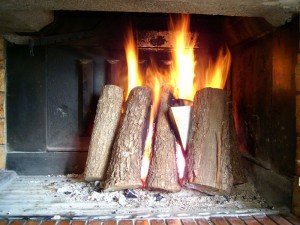Fireplaces are a beautiful addition to any room that can provide warmth and ambiance throughout the cold winter months. However, most homeowners pay more attention to what they get out of their fireplaces than what they put in.
What materials you burn in your fireplace can have a direct impact on fireplace performance. In addition, attempting to burn materials that are not meant for residential fireplaces can pose a safety hazard through unmanageable burning or the release of toxic chemicals.
Garbage
More popular in rural areas and communities, burning garbage is not a safe way to dispose of your trash. While there are a growing number of waste-to-energy factories in the United States that burn trash to create useable electricity, these plants are specially designed to filter any toxins or chemicals out of the air supply. Homeowners simply do not have the technology to do this, causing the chemical byproducts of whatever is being burned to enter the atmosphere. Backyard burning has been found to increase the risk of heart disease, aggravate asthma and emphysema, and can also cause rashes, nausea, or headaches.
Green wood
Homeowners should avoid burning green, or freshly cut wood, whenever possible. While green wood will burn, it produces less heat than seasoned firewood because more energy is needed to evaporate the remaining water in the wood itself. In addition, green wood produces large amounts of smoke, which can easily backdraft and fill a room. Finally, burning green wood produces more creosote, a gummy, corrosive, and highly flammable substance that coats the inside of the chimney structure.
Paper products
While burning used wrapping paper or pizza boxes may seem like an easy way to dispose of them, it can actually create a chimney fire. Paper burns extremely quickly, which can cause an enormous increase in the amount of flames if too much is put into the fireplace. These large fires cannot be contained by the firebox, causing flames to travel up the chimney or out into the room.
In addition, most wrapping paper and other printed products are not designed to be burned. While companies based in the United States use approved chemicals and dyes in their paper products, most printed paper produced outside the country does not. Because of this, colored wrapping paper may produce toxic chemicals when burned. Instead of burning them, wrapping paper, cardboard, and other paper products should be recycled or thrown away in the regular trash.
Pretreated wood
After removing old fencing, decking, or playground equipment, many homeowners believe that using the old materials as firewood is an appropriate way to recycle them. However, any wood that has been exposed to glue, paint, stain, varnish, or other chemical treatments should never be burned. The EPA recommends that homeowners “never burn coated, painted, or pressure-treated wood because it releases toxic chemicals when burned.”
Styrofoam
Although Styrofoam burns quickly, putting it into the fireplace is an environmental hazard. When burned, Styrofoam and other packing foams erupt in a cloud of toxic black smoke, releasing chemicals that can damage the nervous system and lungs. In addition, the melted foam particles can stick to the inside of the firebox and chimney structure, creating a future fire hazard if they were to reignite.
Instead, homeowners should only burn properly seasoned firewood in their fireplaces. While different species of trees have different burn characteristics, being dry is by far the most important characteristic of any potential firewood.


